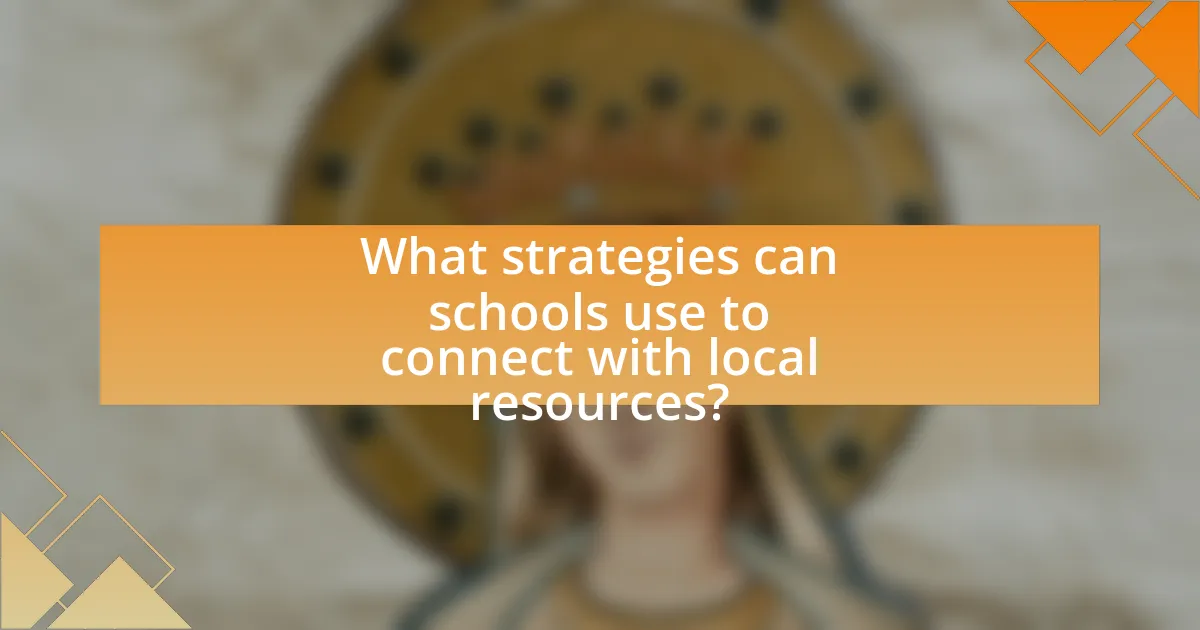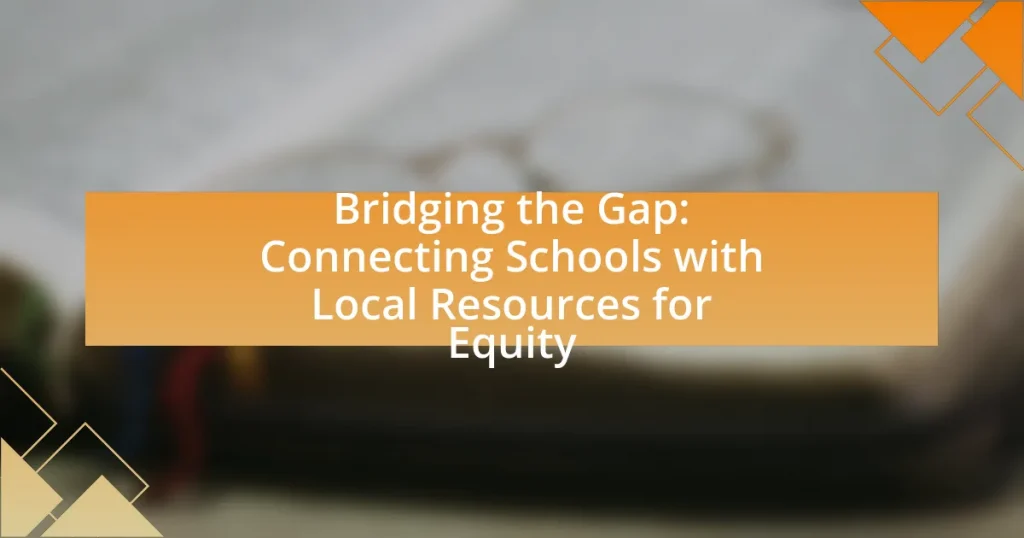The article “Bridging the Gap: Connecting Schools with Local Resources for Equity” focuses on the importance of integrating local resources into educational frameworks to promote equity among students. It outlines how partnerships with community organizations, businesses, and government agencies can provide essential support, such as tutoring and mentorship, particularly for underserved populations. The article discusses current disparities in educational access, the impact of equity on student outcomes, and effective strategies for schools to connect with local resources. Additionally, it highlights the challenges schools face in establishing these connections and offers best practices for building sustainable relationships that enhance educational equity.

What does it mean to bridge the gap between schools and local resources for equity?
Bridging the gap between schools and local resources for equity means creating connections that ensure all students have access to the necessary support and opportunities for success, regardless of their socioeconomic background. This involves integrating community services, such as health care, mentorship programs, and after-school activities, into the educational framework to address disparities in resources. For example, research shows that schools collaborating with local organizations can improve student outcomes by providing additional academic support and social services, thereby fostering an equitable learning environment.
How can connecting schools with local resources promote equity?
Connecting schools with local resources promotes equity by ensuring that all students have access to the same educational opportunities and support systems, regardless of their socioeconomic background. When schools collaborate with local organizations, businesses, and community services, they can provide essential resources such as tutoring, mentorship, and extracurricular activities that may not be available otherwise. For instance, research from the National Education Association indicates that schools with strong community partnerships see improved student performance and engagement, particularly among underrepresented groups. This access to local resources helps to level the playing field, allowing all students to thrive academically and socially.
What are the key local resources that can support schools?
Key local resources that can support schools include community organizations, local businesses, and government agencies. Community organizations often provide tutoring, mentorship programs, and after-school activities that enhance student learning and engagement. Local businesses can offer internships, job shadowing opportunities, and financial support for school events, fostering real-world connections for students. Government agencies typically provide funding, educational resources, and training programs for teachers, ensuring schools have the necessary tools to succeed. These resources collectively contribute to a supportive educational environment, promoting equity and access for all students.
How do these resources address equity issues in education?
These resources address equity issues in education by providing targeted support and access to essential services for underserved communities. For instance, they connect schools with local organizations that offer tutoring, mental health services, and nutritional programs, which are crucial for students facing socioeconomic challenges. Research indicates that schools with strong community partnerships see improved student outcomes, as these resources help to level the playing field for disadvantaged students, ensuring they have the same opportunities for success as their peers.
Why is it important to focus on equity in education?
Focusing on equity in education is crucial because it ensures that all students have access to the resources and opportunities necessary for their academic success. Equity addresses disparities in educational outcomes caused by socioeconomic status, race, and other factors, promoting a fair learning environment. Research indicates that equitable education can lead to improved student performance, higher graduation rates, and better long-term economic outcomes. For instance, a study by the National Center for Education Statistics found that schools with equitable resource distribution significantly outperform those with high levels of inequality. Therefore, prioritizing equity in education is essential for fostering an inclusive and effective educational system.
What are the current disparities in educational access and resources?
Current disparities in educational access and resources include significant gaps based on socioeconomic status, geographic location, and racial or ethnic backgrounds. For instance, students in low-income areas often attend underfunded schools that lack essential resources such as qualified teachers, advanced coursework, and technology. According to the National Center for Education Statistics, schools in high-poverty areas receive about $1,200 less per student than those in wealthier districts. Additionally, rural schools frequently face challenges in accessing educational materials and extracurricular opportunities compared to urban schools, exacerbating the inequities. These disparities hinder equitable educational outcomes and limit opportunities for marginalized groups.
How does equity impact student outcomes and community development?
Equity significantly enhances student outcomes and community development by ensuring that all students have access to the necessary resources and support to succeed academically and socially. When educational institutions prioritize equity, they address disparities in funding, resources, and opportunities, which leads to improved academic performance, higher graduation rates, and increased college enrollment among marginalized groups. For instance, research from the National Center for Education Statistics shows that schools with equitable funding models demonstrate better student achievement metrics compared to those with significant funding disparities. Furthermore, equitable practices foster community development by creating a more educated workforce, reducing poverty levels, and promoting social cohesion, as evidenced by studies indicating that communities with equitable educational systems experience lower crime rates and enhanced economic growth.

What strategies can schools use to connect with local resources?
Schools can connect with local resources by establishing partnerships with community organizations, businesses, and local government agencies. These partnerships can facilitate access to services such as tutoring, mentorship programs, and health services, which enhance educational equity. For instance, a study by the National Education Association highlights that schools collaborating with local nonprofits can improve student outcomes by providing additional support and resources tailored to community needs. Furthermore, schools can organize community events to engage families and local stakeholders, fostering a sense of belonging and collaboration that strengthens these connections.
How can schools identify and engage with local organizations?
Schools can identify and engage with local organizations by conducting community assessments and establishing partnerships. Community assessments involve gathering data on local resources, needs, and organizations through surveys, interviews, and public records, which helps schools understand the landscape of available support. Establishing partnerships can be achieved by reaching out to local nonprofits, businesses, and government agencies, fostering collaboration through meetings, joint events, and shared initiatives. Research indicates that schools that actively engage with local organizations can enhance educational opportunities and resources for students, as evidenced by programs like the Community Schools model, which integrates academic, health, and social services to support student success.
What role do community partnerships play in resource connection?
Community partnerships play a crucial role in resource connection by facilitating access to essential services, funding, and support for schools. These collaborations enable educational institutions to leverage local expertise and resources, enhancing their ability to meet diverse student needs. For instance, partnerships with local businesses can provide internships and mentorship opportunities, while collaborations with non-profits can offer tutoring and mental health services. Research indicates that schools engaged in community partnerships often see improved student outcomes, as these connections help bridge gaps in resources and support systems, ultimately fostering equity in education.
How can schools leverage local businesses for support?
Schools can leverage local businesses for support by establishing partnerships that provide resources, funding, and mentorship opportunities. These collaborations can include sponsorships for school events, donations of supplies, or internships for students, which enhance educational experiences. For instance, a study by the National School Boards Association found that schools with strong community partnerships reported higher student engagement and improved academic performance. By actively engaging local businesses, schools can create a mutually beneficial relationship that fosters community involvement and enhances educational equity.
What are effective methods for integrating local resources into school programs?
Effective methods for integrating local resources into school programs include establishing partnerships with local businesses, community organizations, and cultural institutions. These collaborations can provide students with real-world learning experiences, such as internships and mentorships, which enhance educational outcomes. For instance, schools that partner with local museums can incorporate hands-on learning opportunities that align with their curriculum, thereby enriching students’ understanding of subjects like history and science. Additionally, utilizing local experts as guest speakers or workshop leaders can bring diverse perspectives and skills into the classroom, fostering a more inclusive learning environment. Research shows that schools that actively engage with their communities see improved student engagement and academic performance, highlighting the importance of these integration methods.
How can schools create programs that utilize local resources effectively?
Schools can create programs that utilize local resources effectively by establishing partnerships with community organizations, businesses, and local government. These collaborations enable schools to access resources such as funding, expertise, and materials that enhance educational programs. For instance, a study by the National Education Association highlights that schools that engage with local businesses for internships and mentorship programs see improved student engagement and career readiness. Additionally, integrating local cultural and historical resources into the curriculum fosters a sense of community and relevance in students’ learning experiences. By leveraging these local assets, schools can create tailored programs that meet the specific needs of their students and the community.
What are some examples of successful resource integration in schools?
Successful resource integration in schools includes partnerships with local businesses, community organizations, and universities. For instance, the “Communities in Schools” program effectively connects students with essential resources such as tutoring, mentoring, and health services, resulting in improved academic performance and reduced dropout rates. Additionally, the “School-Community Partnerships” initiative in Chicago has successfully integrated resources by collaborating with local nonprofits to provide after-school programs, which have led to increased student engagement and attendance. These examples demonstrate how strategic resource integration can enhance educational equity and support student success.

What challenges do schools face in bridging the gap with local resources?
Schools face significant challenges in bridging the gap with local resources, primarily due to funding disparities and lack of community engagement. Many schools, especially in low-income areas, struggle with insufficient budgets that limit their ability to access and utilize local resources effectively. According to the National Center for Education Statistics, schools in high-poverty areas receive about $1,000 less per student than those in wealthier districts, which directly impacts their capacity to form partnerships with local organizations. Additionally, schools often encounter difficulties in fostering relationships with local businesses and community groups, as these entities may not prioritize educational collaboration or may lack awareness of the needs of schools. This disconnect can hinder the development of programs that leverage local resources to enhance educational equity.
What barriers exist in connecting schools with local resources?
Barriers that exist in connecting schools with local resources include lack of communication, insufficient funding, and limited awareness of available resources. Schools often struggle to establish effective communication channels with local organizations, which hinders collaboration. According to a study by the National Education Association, 60% of educators reported that inadequate funding restricts their ability to access community resources. Additionally, many schools and local organizations are unaware of each other’s capabilities and offerings, leading to missed opportunities for partnership.
How can schools overcome funding and resource allocation challenges?
Schools can overcome funding and resource allocation challenges by actively engaging with local communities and leveraging partnerships with businesses and organizations. This approach allows schools to tap into additional financial resources and in-kind support, which can enhance educational programs and facilities. For instance, a study by the National Education Association found that schools that collaborated with local businesses reported a 20% increase in funding for extracurricular activities and resources. Additionally, schools can implement grant-writing initiatives to secure funding from government and private sources, further diversifying their financial support. By fostering these connections and seeking alternative funding avenues, schools can effectively address their resource allocation challenges.
What are the communication challenges between schools and local organizations?
Communication challenges between schools and local organizations include misalignment of goals, lack of consistent communication channels, and differing priorities. Schools often focus on educational outcomes, while local organizations may prioritize community engagement or resource distribution, leading to misunderstandings. Additionally, inconsistent communication methods, such as varying frequencies and formats of updates, can hinder effective collaboration. Research indicates that 70% of partnerships between schools and community organizations fail due to these misalignments and communication barriers, highlighting the need for structured communication strategies to foster collaboration.
How can schools measure the impact of local resource connections on equity?
Schools can measure the impact of local resource connections on equity by analyzing student performance data, engagement levels, and access to resources before and after establishing these connections. For instance, schools can track metrics such as academic achievement, attendance rates, and participation in extracurricular activities to assess changes linked to local partnerships. Research indicates that schools with strong community ties often see improved student outcomes; a study by the Harvard Family Research Project found that community engagement can lead to a 20% increase in student achievement. By systematically collecting and comparing this data, schools can evaluate the effectiveness of local resource connections in promoting equity among students.
What metrics can be used to assess the effectiveness of these connections?
Metrics that can be used to assess the effectiveness of connections between schools and local resources include student engagement levels, academic performance indicators, resource utilization rates, and community feedback. Student engagement levels can be measured through attendance records and participation in programs, indicating how well students are connecting with local resources. Academic performance indicators, such as standardized test scores and grade improvements, provide quantitative evidence of the impact of these connections on educational outcomes. Resource utilization rates, which track the frequency and extent to which local resources are accessed, reflect the practical effectiveness of the partnerships. Community feedback, gathered through surveys and focus groups, offers qualitative insights into the perceived value and impact of these connections on both students and the community.
How can feedback from students and families inform improvements?
Feedback from students and families can inform improvements by providing direct insights into their experiences and needs within the educational environment. This feedback allows schools to identify specific areas requiring enhancement, such as curriculum relevance, teaching methods, and support services. For instance, a study by the National Education Association found that schools that actively sought and implemented feedback from families saw a 20% increase in student engagement and satisfaction. By analyzing this feedback, schools can tailor their resources and strategies to better align with the community’s expectations and requirements, ultimately fostering a more equitable educational experience.
What best practices can schools adopt for successful resource connections?
Schools can adopt collaborative partnerships with local organizations to enhance resource connections effectively. By establishing relationships with community groups, businesses, and non-profits, schools can access a wider range of resources, including funding, mentorship, and educational materials. Research indicates that schools engaged in community partnerships report improved student outcomes and increased resource availability, as highlighted in the study “Community Schools: A Strategy for Integrating Services and Improving Student Outcomes” by the Coalition for Community Schools. This approach not only fosters a supportive learning environment but also promotes equity by ensuring that all students have access to necessary resources.
How can schools build sustainable relationships with local resources?
Schools can build sustainable relationships with local resources by actively engaging with community organizations, businesses, and local governments to create partnerships that benefit both students and the community. For instance, schools can establish mentorship programs with local businesses, allowing students to gain real-world experience while providing businesses with a skilled future workforce. Research shows that schools that collaborate with local entities see improved student outcomes, as these partnerships often lead to enhanced educational resources and opportunities. A study by the National Education Association highlights that schools with strong community ties report higher student engagement and academic performance, demonstrating the effectiveness of such relationships.
What are the key elements of a successful resource connection strategy?
A successful resource connection strategy includes clear communication, stakeholder engagement, and data-driven decision-making. Clear communication ensures that all parties understand the goals and processes involved in resource connection, facilitating collaboration. Stakeholder engagement involves actively involving community members, local organizations, and educational institutions to foster partnerships that enhance resource availability. Data-driven decision-making relies on assessing community needs and resource effectiveness through metrics, which guides strategic planning and implementation. These elements are essential for creating equitable access to resources in educational settings, as evidenced by studies showing that effective partnerships can significantly improve student outcomes and community involvement.



